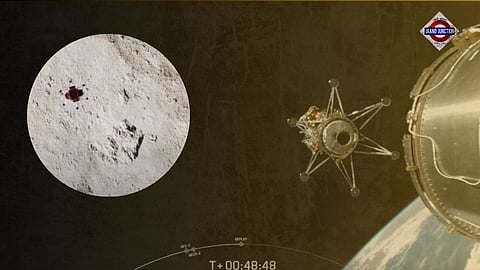

It was in the year 1969 when the Moon became part of Earth as astronaut Neil Armstrong set foot on the alien world.
For the next few years, there was a constant flow of resources and manpower to this strange rugged world. Then in 1972, it all stopped as Apollo missions were grounded. The lull lasted over half a century.
Over 50 years after Commander Eugene Cernan left the Moon, Nasa in collaboration with private Intuitive Machines, has landed the first American spacecraft on the Moon.
While the spacecraft has landed on the Moon, the signal it is transmitting from the south polar region is weak. The Odysseus team was briefly nervous when the lander did not respond in the moments after landing. However, a faint signal confirmed it had indeed landed. "We are not dead yet. Odysseus has a new home," the team confirmed in the live stream.
Odysseus landed in Malapert A, a crater just 300 kilometers away from the Moon's South Pole, an unexplored and dangerous region. This area is named after Charles Malapert, a figure from the annals of astronomy, and is composed of lunar highland material same as that found at the Apollo 16 landing site.
Odysseus began its journey aboard the SpaceX Falcon-9 rocket as it launched from the Kennedy Space Centre on February 15, which propelled it on a direct path to Earth's closest celestial neighbour. The spacecraft separated from the giant payload fairing of the rocket minutes after it entered the coldness of space.
Engineers had taken a leaf out of history to ace this mission by putting the spacecraft on the same route as that taken by the Apollo missions to the Moon.
The direct path that would bring it to the Moon in just eight days, unlike India's Chandrayaan-3 which took weeks to maneuver around Earth to gain additional speed to reach the Moon.
The lander was powered by a cryogenic propulsion system, allowing for a swift and efficient journey, bypassing the Van Allen belts, and minimising radiation exposure to its electronics.
The lander is carrying a suite of six payloads for Nasa under the Commercial Lunar Payload Services (CLPS) initiative, including scientific instruments to measure the plasma environment and provide data for future Artemis astronauts.
It will test new technologies such as a LIDAR-based sensor for descent velocity and range sensing, and an electrostatic dust-removal system that could revolutionise spacesuit technology. A Laser Retro-Reflector Array will enable precise determination of the lander’s location on the Moon's surface, aiding in navigation and scientific measurements in the future.
Odysseus will also capture images of the lander's engine plume as it interacts with the lunar surface during descent and after landing. These images will now be downlinked and analysed. A CubeSat-sized S-band radio navigation beacon also accompanied the spacecraft to demonstrate autonomous spacecraft positioning.
Engineers plan to use the spacecraft to capture some of the first images of the Milky Way Galaxy Center from the Moon.
With Odysseus now in its destined location on the Moon, science will begin, depending on the signal acquisition, as the sunlight on the Moon's South Pole is always in short supply. The spacecraft has seven days.
